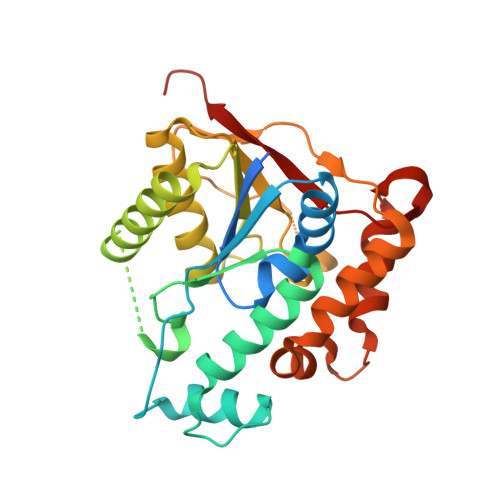Teicoplanin Reprogrammed with the N-Acyl-Glucosamine Pharmacophore at the Penultimate Residue of Aglycone Acquires Broad-Spectrum Antimicrobial Activities Effectively Killing Gram-Positive and -Negative Pathogens.
Huang, C.M., Lyu, S.Y., Lin, K.H., Chen, C.L., Chen, M.H., Shih, H.W., Hsu, N.S., Lo, I.W., Wang, Y.L., Li, Y.S., Wu, C.J., Li, T.L.(2019) ACS Infect Dis 5: 430-442
- PubMed: 30599088
- DOI: https://doi.org/10.1021/acsinfecdis.8b00317
- Primary Citation of Related Structures:
6IIX, 6IIY - PubMed Abstract:
Lipoglycopeptide antibiotics, for example, teicoplanin (Tei) and A40926, are more potent than vancomycin against Gram-positive (Gram-(+)) drug-resistant pathogens, for example, methicillin-resistant Staphylococcus aureus (MRSA). To extend their therapeutic effectiveness on vancomycin-resistant S. aureus (VRSA), the biosynthetic pathway of the N-acyl glucosamine (Glc) pharmacophore at residue 4 (r4) of teicoplanin pseudoaglycone redirection to residue 6 (r6) was attempted. On the basis of crystal structures, two regioselective biocatalysts Orf2*T (a triple-mutation mutant S98A/V121A/F193Y) and Orf11*S (a single-mutation mutant W163A) were engineered, allowing them to act on GlcNAc at r6. New analogs thereby made show marked antimicrobial activity against MRSA and VRSA by 2-3 orders of magnitude better than teicoplanin and vancomycin. The lipid side chain of the Tei-analogs armed with a terminal mono- or diguanidino group extends the antimicrobial specificity from Gram-(+) to Gram-negative (Gram-(-)), comparable to that of kanamycin. In addition to low cytotoxicity and high safety, the Tei analogs exhibit new modes of action as a result of resensitization of VRSA and Acinetobacter baumannii. The redirection of the biosynthetic pathway for the N-acyl-Glc pharmacophore from r4 to r6 bodes well for large-scale production of selected r6,Tei congeners in an environmentally friendly synthetic biology approach.
Organizational Affiliation:
Genomics Research Center , Academia Sinica , 128 Academia Road , Section 2, Nankang, Taipei 11529 , Taiwan.
















